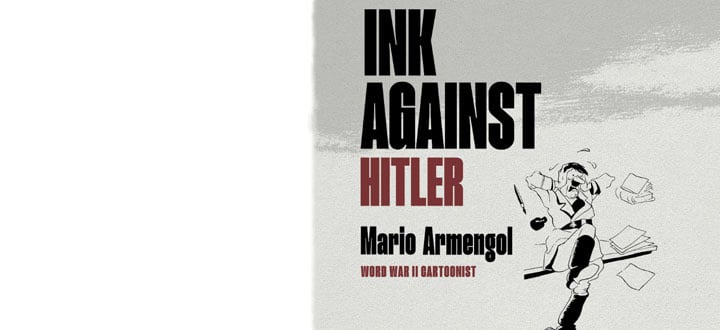Commented works: From Forerunners to a Blind People
11 - Diego de la Cruz (act. in Burgos)
Christ of Mercy between the Prophets David and Jeremiah
c. 1495–1500. Oil on panel
The three figures depicted each hold a ribbon scroll: that of Christ Man of Sorrows alludes to the Passion, those of the prophets to the Incarnation. Evidence of a visual association between the figure of David and the image of the Man of Sorrows, an emblem of Christ's triumph over death, dates back to the 13th century. According to the Scriptures, the Old Testament king and prophet David was a herald of Jesus' resurrectio.
Donació de la família Várez Fisa, 2013.
Museo Nacional del Prado, Madrid.
HEBREW MS. 6
12 - Matfre Ermengaud de Béziers
Breviari d’Amor, EThe Devil prevents the Jews from understanding the
Scriptures
c. 1375–1400. Illuminated parchment
The figures of the Fathers of the Church illustrate the Messianic prophecies. Beside them is a meaningful image: a devil blindfolds a Jewish man, preventing him from reading a book. Blindness expresses the idea of Judaism’s obstinate denial of the Scriptures. As the Catalan title heading the image states: ‘the blind Jew does not understand his Hebrew’. To emphasise the point, the sacred text is transcribed in Hebrew.
The British Library, Londres. MS. Yates Thompson 31
13 - Palencia workshop
Synagoga
c. 1250–1300. Polychrome wood
Blindfolded and with her head tilted in a gesture of sadness, for Christians this elegant personification of the Synagogue symbolises the defeat of the Old Testament. Like the woodcarving of the Church on view here, it probably comes from a Castilian Crucifixion. The Synagogue once ruled, but her time is over: her crown is now worn by the Church, who governs while awaiting the second coming of Christ.
«El Conventet» collection, Barcelona
14 - Fernando Gallego (act. in Castile)
Christ blessing
c.1494–96. Oil on panel
On either side of the enthroned Christ are the allegories of the Church, a young woman with a laurel crown holding a chalice and carrying a cross-topped standard, and the Synagogue, a decrepit, blindfolded old woman with a broken staff. The yellow of her pennant and dress is a negative sign: this colour had been linked to falsehood and treason since the 13th century. This explains its association with Judas and, through an evidently defamatory intention, with Judaism and the Synagogue.
Museo Nacional del Prado, Madrid
15 - Palencia workshop
Ecclesia
c.1250–1300. Polychrome wood
The allegory of the Church is a young queen who asserts her authority on earth: she is crowned and attired in a dalmatic, chasuble and alb. Judging by the hole visible in her right hand, she must have held a staff or chalice. Church and Synagogue are personifications, but medieval audiences viewed them as specific characters. Moreover, they are a metaphor for Jews' subjection to Christianity and their possible conversion at the end of time
Fundación Francisco Godia, Barcelona
16 - Matfre Ermengaud de Béziers
Breviari d’Amor, The Devil prevents the Jews from understanding the
Scriptures
c. 1375–1400. Illuminated parchment
The figures of the Fathers of the Church illustrate the Messianic prophecies. Beside them is a meaningful image: a devil blindfolds a Jewish man, preventing him from reading a book. Blindness expresses the idea of Judaism’s obstinate denial of the Scriptures. As the Catalan title heading the image states: ‘the blind Jew does not understand his Hebrew’. To emphasise the point, the sacred text is transcribed in Hebrew.
THE BRITISH LIBRARY, LONDRES. MS. YATES THOMPSON 31
17 - Circle of Ferrer and Arnau Bassa (Act .in Catalonia)
Saint Stephen preaching in the Synagogue
c. 1340-50. Tempera and gold leaf on panel
In this image, which is designed to show the superiority of the Christian faith, the Jews react to Stephen's words with a mixture of acceptance, disbelief and despair. Some are dressed in long, hooded tunics. The 4th Lateran Council (1215) ruled that Jews and Muslims should wear some kind of identifying sign to distinguish them from Christians. Although the legislation on clothing was limited in enforcement, it gave rise to the creation of a series of discriminatory iconographic codes.
Museu Nacional d’Art de Catalunya, Barcelona
18 - Nicolás and Martín Zahortiga (act. in Aragon)
Christ among the Doctors (from the retable of Santa María de Borja)
1465–77. Tempera on panel
Unlike most representations of this theme, here the Jewish priests listen attentively to Jesus' words. It is worth noting that instead of sporting the Jewish cloak, they are characterised by oriental-looking headdresses resembling those worn by Muslims of Valencia and Aragon. This is another iconographic device for visually marking the religious frontier separating Jews from Christians.
Museo de la Colegiata de Santa María, Borja (Zaragoza)
19 - Circle of Jaume Cascalls (act. in Catalonia)
The Prophet Daniel
c. 1360. Polychrome limestone
The origin of this sculpture is unknown. However, as prophets were not usually represented individually, it is reasonable to conjecture that it was once part of a larger ensemble. During the Late Middle Ages groups of images of Old Testament kings and prophets were designed as essential complements of New Testament cycles. Their purpose was to herald the Incarnation and the Messiah's redemptive sacrifice.
Casacuberta Marsans Collection
20 - Master of Saint George and the Princess (act. in Aragon)
Saint Daniel
c. 1455-60. Tempera on panel
Prophets, sometimes paired with the Evangelists or Fathers of the Church, are commonly found in the outer sections of Gothic altarpieces. A likely example is this small panel painting of the prophet Daniel, who is recognisable from the inscription referring to one of his eschatological prophecies. It was probably part of the predella or lower area of a larger ensemble.
Llegat Pablo Bosch y Barrau, 1916
Museo Nacional del Prado, Madrid










